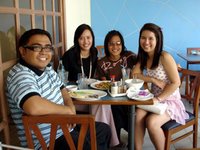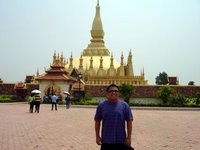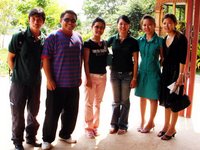As I mentioned in my previous post, land travel in Southeast Asia can be difficult. Just right after I posted the last entry, Ton had to rush me to the hospital at 2:30 a.m.! Hehe! Let's not get into the details but it was sort of a result of that long trip. And the rest of the plans almost got cancelled if I did not improve. Luckily I did and I'm at it again. Hehe!

So I rested the whole morning and met up with more of my SSEAYP batchmates for lunch. I took a subway from Ton's apartment then a skytrain to
Siam Square where Nun would meet me. We had lunch with Bee at See Fah restaurant. Cee joined us as well. In the photo are myself, Bee, Cee and Nun.

After lunch, Nun accompanied me around
Siam Paragon, a really nice mall which is said to be the largest in Asia. That's why Mayor Atienza shouldn't have demolished heritage structures like the YMCA Building and the San Lazaro Racetrack, replacing it with two SM malls because unless SM stops building those prefab malls (no unique design whatsoever), it's no attraction at all. Sigh! I liked the greenery inside the mall. Nicely done! We had some ice cream. A lot of unique flavors like red bean and green tea, horlicks, ovaltine, roasted sesame, etc. Yummy!
It was then off to catch a skytrain to Mo Chit Station where Matong would meet me to accompany me to the bus station. I had wanted to take a train to
Nong Khai so that I could sleep comfortably but it was fully-booked a long time ago since it's New Year in Thailand as well as in Cambodia and Laos. So I had to make do with a bus. Little did I know that the ride was going to be another horrible fourteen hour trip! Imagine the Holy Week rush to the provinces. In Thailand, it was the same rush for the long holiday. Sigh!
For some reason, we got a ticket easily. I got on board the bus at 4:30 p.m. It was scheduled to leave at 5 p.m. We left a little late though. When we were on our way, I slept only to wake up an hour later since we were in another bus station stuffing in more passengers. When we left the first station, we were already full. But the bus was not satisfied, they placed stools in the center!
When I thought we've loaded enough, the bus just kept on stopping trying to lure in more passengers. My God! Greedy is the only term I could think of. Thailand and the Philippines as well should enact a law against overloading. If there are no more seats, they shouldn't overload. It may be ok for those in the center that they are in the center aisle but did they care to ask those seated comfortably earlier if it was ok with them? Hmmm... And the air-conditioning wasn't that strong.
By the time we got to another station, (yes, we stopped at a third, fourth and fifth station if I remember things right) passengers were already complaining since we were always stopping! To make the long story short, I wasn't able to sleep well since we were so cramped up.
We arrived in Nong Khai at about 6:30 a.m. just in time for me to get a ticket for the 7:30 a.m. bus to
Vientiane. At least it was more comfortable but just a short ride to the border and the
Friendship Bridge to
Laos. The Friendship Brigde is the most popular border crossing between Thailand and Laos. And at least I did not have to walk far since the bus took us to the other side.

By 8:30 a.m., we were in Laos. It's a good thing Filipinos don't need visas in all ASEAN countries except Myanmar. I didn't go to Vientiane with the bus since Loulou, another SSEAYP batchmate was at the border with Tuy to meet me. We picked up another Tuy at her house then went to Kao's shop. Since Loulou had to go to work, Kao, Tuy and Tuy would take me around.
We first went to
Patuxai, an imposing concrete monument which is sort of Laos' version of the Arc de Triomphe. It was built to commemorate those who died in battle with concrete donated by the U.S. supposedly for a new airport runway. Hehe! There was a cafe underneath and you could climb up to the top but I was just too exhausted. The interior was nice but it seemed like an unfinished structure when seen up close from the outside.

After that, we proceeded to another imposing structure, the
That Luang, the national symbol of Laos and its most important religious building. The present gold leaf stupa is a recreation of the 16th century temple thought to have been built by the King.
Outside the stuppa, we bought roasted honeycombs from a hawker and let me taste. Hmmm... not my type especially since there were bees roasted in it too. I thought it would taste like honey. Hehe! It had this wierd aftertaste as well. They were also selling live snakes! I had some roasted banana as well.

We then had lunch at Loulou's place since they were having a new year celebration there. Joy, another ex-PY joined us. For good luck on new year, we ate lamb aside from other dishes. There was so much food including a whole roasted-calf! It was a good introduction to Lao cuisine. In the photo are Joy, myself, Tuy, Loulou, Tuy and Kao.
Then, it was off the the Ho Phrakeo (below). This temple, built in A.D.1565 by King Xaisetathirat, is the oldest temple in Vientiane. You would notice outside a sign that the temple used to house an emerald Buddha image which has been out of the country for several centuries now. Well, that emerald Buddha is the one in Thailand after it was captured during an invasion.

Anyway, I'm resting now since I'll be off for another long bus ride to the UNESCO World Heritage town of Luang Prabang. I should prepare to get wet within the next few days since the new year celebrations in this part of Southeast Asia tend to become water wars. Sigh!































